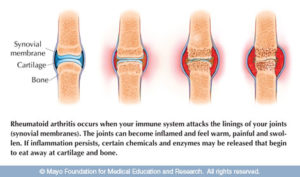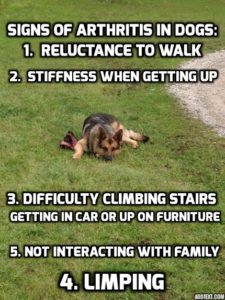Arthritis, or Degenerative Joint Disease
 Arthritis, or degenerative joint disease, is the most common orthopedic disease that brings dogs to the veterinarian. Arthritis is the same process no matter the species. It all starts with inflammation in the joint. This can be the product of repeated motion whether it be a pet playing ball or chasing bees every day or a working dog in consistent strenuous training. Arthritis can also be the result of an injury: a running dog spins too fast and causes damage to the joint, or blunt trauma directly damages joint structures. Whatever the cause, there is inflammation, pain, and decreased range of motion. A joint is where two bones come together. The ends of the bones where they touch, are covered by cartilage which looks and feels like an over boiled egg. The cartilage allows the bones to glide smoothly together and helps to absorb the shock of motion. Surrounding the ends of the bones and lining all surfaces within a joint is a tissue called the synovial membrane. The important role of this membrane is to produce and release joint fluid to nourish the cartilage. During the early stages of arthritis, inflammatory cells and chemicals are released into the joint causing the degradation of the cartilage. The cartilage thins, breaks apart, and eventually dissolves leaving a very painful bone on bone situation.
Arthritis, or degenerative joint disease, is the most common orthopedic disease that brings dogs to the veterinarian. Arthritis is the same process no matter the species. It all starts with inflammation in the joint. This can be the product of repeated motion whether it be a pet playing ball or chasing bees every day or a working dog in consistent strenuous training. Arthritis can also be the result of an injury: a running dog spins too fast and causes damage to the joint, or blunt trauma directly damages joint structures. Whatever the cause, there is inflammation, pain, and decreased range of motion. A joint is where two bones come together. The ends of the bones where they touch, are covered by cartilage which looks and feels like an over boiled egg. The cartilage allows the bones to glide smoothly together and helps to absorb the shock of motion. Surrounding the ends of the bones and lining all surfaces within a joint is a tissue called the synovial membrane. The important role of this membrane is to produce and release joint fluid to nourish the cartilage. During the early stages of arthritis, inflammatory cells and chemicals are released into the joint causing the degradation of the cartilage. The cartilage thins, breaks apart, and eventually dissolves leaving a very painful bone on bone situation.
Arthritis in Older Dogs
 Most dogs with arthritis are senior dogs, and because of the arthritis pain, activity becomes very painful. Now it becomes an older dog that spends most of the day laying around. Owners often feel sorry for them so in addition to meals, they receive more snacks and treats. It does not take long for our old arthritic dog to become obese. You can see how the problem snowballs; if the painful joints couldn’t support the normal weight, they surely can’t support the overweight body…
Most dogs with arthritis are senior dogs, and because of the arthritis pain, activity becomes very painful. Now it becomes an older dog that spends most of the day laying around. Owners often feel sorry for them so in addition to meals, they receive more snacks and treats. It does not take long for our old arthritic dog to become obese. You can see how the problem snowballs; if the painful joints couldn’t support the normal weight, they surely can’t support the overweight body…
While arthritis can’t be cured, it can be managed reasonably well depending on how aggressive you want to get with it. There are safer and more effective anti-inflammatory medications. There are much improved oral and injectible joint supplements. Stem cells and platelet rich plasma are almost commonplace now. There is laser therapy and therapeutic ultrasound, pulsed electromagnetic field therapy; aquatic therapy and specific therapeutic exercise protocols. You may find that many of these options cost less than you fear.
Diagnosis of Arthritis
When we have a pet come in for canine rehabilitation after a diagnosis of arthritis, we go over all the options with the owners, as well as some changes that can be made to the pet’s home environment. Often the pet is carrying some extra weight and that must be addressed as well. Once appropriate medication is selected, and dietary changes discussed, we start with simple range of motion exercises and aquatic therapy. Moving joints through their ranges of motion helps increase blood flow to the damaged tissue and restore some muscular flexibility. Starting the dogs in the pool allows exercise (cardiovascular, strength, and calorie burning effects) without putting the stress of weight-bearing during the work out on the joints. Just because your pet has been given a diagnosis of arthritis in one or more limbs, it does not mean his active life is over. Taking a ‘whole dog’ approach to treatment, can make all the difference to his world, and you can have your active companion by your side for more years to come.

Recent Comments